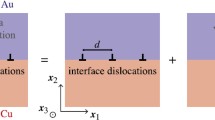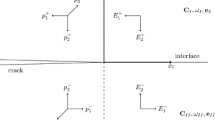Abstract
Interfacial dislocations and cracks in anisotropic bimaterials are considered. The displacement and the stress fields due to an interfacial dislocation are obtained in a real and simple form. Explicit solutions to the traction along the interface and the crack opening displacement for a Griffith interface crack are derived. Possible definitions of stress intensity factors are given which reduce to the classical definition for a crack in a homogeneous medium. It is found that a planar interface between dissimilar anisotropic solids is completely characterized by no more than 9 independent parameters. Some invariant properties of the dislocation and crack solutions under coordinate transformation are also discussed.
Similar content being viewed by others
References
J. Dundurs and T. Mura. Interaction between an edge dislocation and a circular inclusion.J. Mech. Phys. Solids 12 (1964) 177–189.
M. Comninou, A property of interface dislocation.Phil. Mag. 36 (1977) 281–283.
M.L. Williams, The stress around a fault or crack in dissimilar media.Bull. Seismol. Soc. Amer. 49 (1959) 199–204.
F. Erdogan, Stress distribution in bonded dissimilar materials with cracks.J. Appl. Mech. 32 (1965) 403–410.
J.R. Rice and G.C. Sih, Plane problem of cracks in dissimilar media.J. Appl. Mech. 32 (1965) 418–423.
A.H. England, A crack between dissimilar media.J. Appl. Mech. 32 (1965) 400–402.
J.W. Hutchinson, M. Mear and J.R. Rice, Crack paralleling an interface between dissimilar materials.J. Appl. Mech. 54 (1987) 828–832.
J.R. Rice, Elastic fracture mechanics concepts for interfacial cracks.J. Appl. Mech. 55 (1988) 98–103.
S. Nakahara and J.R. Willis, Some remarks on interfacial dislocations.J. Phys. F: Metal Phys. 3 (1973) L249-L254.
D.M. Barnett and J. Lothe, An image force theorem for dislocations in anisotropic bicrystals.J. Phys. F: Metal Phys. 4 (1974) 1618–1635.
O.K. Kirchner and J. Lothe. Displacements and tractions along interfaces.Phil. Mag. A 56 (1987) 583–594.
M. Gotoh, Some problems of bonded anisotropic plates with cracks along the bond.Int. J. Fracture Mech. 3 (1967) 253.
D.L. Clements, A crack between dissimilar anisotropic media.Int. J. Engng Sci. 9 (1971) 257–265.
R.J. Willis, Fracture mechanics of interfacial cracks.J. Mech. Phys. Solids 19 (1971) 353–368.
J.L. Bassani and J. Qu, Finite cracks on bimaterial and bicrystal interfaces.J. Mech. Phys. Solids 37 (1989) 435–453.
T.C.T. Ting, Explicit solution and invariance of the singularities at an interface crack in anisotropic composites.Int. J. Solids Structures 22 (1986) 965–983.
J. Qu and J.L. Bassani, Cracks on bimaterial and bicrystal interfaces.J. Mech. Phys. Solids 37 (1989) 417–433.
T.C.T. Ting, Line force and dislocations in anisotropic elastic composite wedges and spaces. Phys. Stat. Sol. (b), 145 (1988) 81–90.
A.N. Stroh, Dislocations and cracks in anisotropic elasticity.Phil. Mag. 7 (1958) 625–646.
Q.Q. Li and T.C.T. Ting, Line inclusion in anisotropic elastic solids.J. Appl. Mech. 56 (1989) 556–563.
T.C.T. Ting and C. Hwu, Sextic formalism in anisotropic elasticity for almost non-semisimple matrixN.Int. J. Solids Structures 24 (1988) 65–76.
D.M. Barnett and J. Lothe, Synthesis of the sextic and the integral formalism for dislocations, Green's functions and surface waves in anisotropic elastic solids.Phys. Norv. 7 (1973) 13–19.
J. Qu, Green's function in anisotropic bimaterials, SIAM Proc. Ser. from the ARO Workshop onRecent Advances on Mathematical Theory of Anisotropic Elasticity, in press.
R.P. Kanwal,Generalized Functions—Theory and Technique. Academic Press (1983).
J. Dundurs and G.P. Sendeckyj, Behavior of an edge dislocation near a bimetallic interface.J. Appl. Phys. 36 (1965) 3353–3354.
J. Dundurs, Discussion.J. Appl. Mech. 36 (1969) 650–652.
N.I. Muskhelishvili,Singular Integral Equations. P. Noordhoff Ltd. (1953).
P. Chadwick and T.C.T. Ting, On the structure and invariance of the Barnett-Lothe tensors.Q. Appl. Math. 45 (1987) 419–427.
J. Qu and J.L. Bassani, Interface cracks between anisotropic elastic solids,Acta/Scripta Metallurgica Proceedings Series 4 (1990) 407–412.
J. Qu and J.L. Bassani, Fracture mechanics of interface cracks in anisotropic bimaterials,J. Appl. Mech., in press.
J.L. Bassani and J. Qu, Interfacial discontinuities and average bimaterial properties,Acta/Scripta Metallurgica Proceedings Series 4 (1990) 401–406.
Author information
Authors and Affiliations
Rights and permissions
About this article
Cite this article
Qu, J., Li, Q. Interfacial dislocation and its applications to interface cracks in anisotropic bimaterials. J Elasticity 26, 169–195 (1991). https://doi.org/10.1007/BF00041220
Received:
Revised:
Issue Date:
DOI: https://doi.org/10.1007/BF00041220




